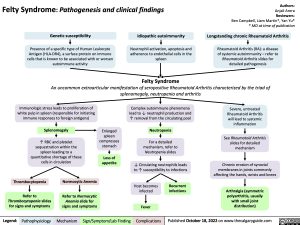Felty Syndrome: Pathogenesis and clinical findings
Authors: Anjali Arora Reviewers: Ben Campbell, Liam Martin*, Yan Yu* * MD at time of publication
Longstanding chronic Rheumatoid Arthritis
Rheumatoid Arthritis (RA): a disease of systemic autoimmunity – refer to Rheumatoid Arthritis slides for detailed pathogenesis
Genetic susceptibility
Presence of a specific type of Human Leukocyte Antigen (HLA-DR4), a surface protein on immune cells that is known to be associated with or worsen autoimmune activity
Idiopathic autoimmunity
Neutrophil activation, apoptosis and adherence to endothelial cells in the spleen
Felty Syndrome
An uncommon extraarticular manifestation of seropositive Rheumatoid Arthritis characterized by the triad of splenomegaly, neutropenia and arthritis
Immunologic stress leads to proliferation of white pulp in spleen (responsible for initiating immune responses to foreign antigens)
Splenomegaly
↑ RBC and platelet sequestration within the spleen leading to a quantitative shortage of these cells in circulation
Enlarged spleen compresses stomach
Loss of appetite
Complex autoimmune phenomena lead to ↓ neutrophil production and ↑ removal from the circulating pool
Neutropenia
For a detailed mechanism, refer to Neutropenia slides
↓ Circulating neutrophils leads to ↑ susceptibility to infections
Severe, untreated Rheumatoid Arthritis will lead to systemic inflammation
See Rheumatoid Arthritis slides for detailed mechanism
Chronic erosion of synovial membranes in joints commonly affecting the hands, wrists and knees
Arthralgia (symmetric polyarthritis, usually with small joint distribution)
Thrombocytopenia
Refer to Thrombocytopenia slides for signs and symptoms
Normocytic Anemia Refer to Normocytic
Anemia slide for signs and symptoms
Host becomes infected
Fever
Recurrent infections
Legend:
Pathophysiology
Mechanism
Sign/Symptom/Lab Finding
Complications
Published October 18, 2022 on www.thecalgaryguide.com

